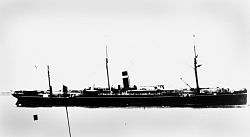Feltria
|
The identical sister ship Jumna
|
||||||||||||||||||||||||
|
||||||||||||||||||||||||
|
||||||||||||||||||||||||
|
||||||||||||||||||||||||
|
||||||||||||||||||||||||
|
||||||||||||||||||||||||
The Feltria was a steamship put into service in 1891 , which in its 26 years of service belonged to a total of seven shipping companies , including the British Cunard Line from 1916 , which used it as a passenger and cargo ship on the North Atlantic . On May 5, 1917, the Feltria was sunk by a German submarine off the coast of southern Ireland.
history
The 5,324 GRT steamship was built at the William Denny and Brothers shipyard in the Scottish port town of Dumbarton for the British India Steam Navigation Company and was launched on June 9, 1891 under the name Avoca . It was the last of three sister ships to be completed . The other two were the Jumna (1886) and the Jelunga (I) (1890). 80 passengers could be carried in first and 1000 in third class. On August 25, 1891, the Avoca ran on her maiden voyage via Calcutta to Brisbane in the service of the Queensland Royal Mail Service.
The ship, 128.01 meters long and 14.69 meters wide, had a chimney, three masts and a single propeller and was equipped with the rigging of a schooner . It was powered by quadruple expansion steam engines producing 666 PSi and allowing a top speed of 14 knots.
Early years
In 1896, the Avoca was temporarily chartered to the Spanish shipping company Compañia Trasatlántica Española (CTE), which was known in the English-speaking world as the Spanish Line. For this company, the ship operated under the name San Fernando between Central America and Cuba and carried mainly troops. Towards the end of the same year, the ship was returned to British India and used again in the Australian service under the old name . In the years 1899 and 1900 the Avoca carried out a total of four troop trips between India and South Africa in the Second Boer War . A fifth voyage followed on duty as a hospital ship . In 1903 it was returned to its owners.
In 1907 the ship was sold to the Danish shipping company East Asiatic Company , for which it was in service as Atlanta . During this time she served as a royal yacht for a visit by the Danish royal couple to Greenland . The following year the ship was transferred to the New York & Continental Line, which again used the original name Avoca . On April 1, 1908, the Avoca left for its first voyage on the Hamburg - Rotterdam - Halifax - New York route . In July 1908 she collided with 300 passengers on board when she entered Hoek van Holland (Netherlands) with a German steamer at anchor. The New York & Continental Line went bankrupt as a result and the ship was auctioned off to CG Ashdown for £ 15,000.
Two months later, it was sold for £ 35,000 to the North West Transport Line, which renamed the ship Uranium . However, the steamer was in poor condition and was only used for emigrant traffic. On April 3, 1909, the Uranium resumed its service between Rotterdam and New York. By April 9, 1910, she completed nine Atlantic crossings on this route. In the same year she was sold to the Uranium Steamship Company, which kept the name Uranium and used the ship on the same route. On June 4, 1910, she left for her first voyage for the new owners.
On January 12, 1913, the steamer ran aground near Halifax in thick fog because he wanted to help the Carthiginian of the Allan Line , which was on fire. The ship was lifted, repaired and put back into service. On July 23, 1914, the Uranium cast off for her last voyage for the Uranium Steamship Company.
Cunard Line
In May 1916 it was taken over by the British Cunard Line, which took over the holdings of the Uranium Steamship Company to compensate for previous war losses. In this train the ship was given the new name Feltria . From November 1916, the ship was used in passenger and freight traffic between Avonmouth and New York .
On May 5, 1917, the Feltria was sunk eight nautical miles off the Mine Head headland on the coast of the southern Irish county of Waterford by the German submarine UC 48 (Oberleutnant zur See Kurt Ramien ) (position 51.56N, 07.24W). 45 people were killed, including the captain of the Feltria , Walter George Price of the British merchant navy .
